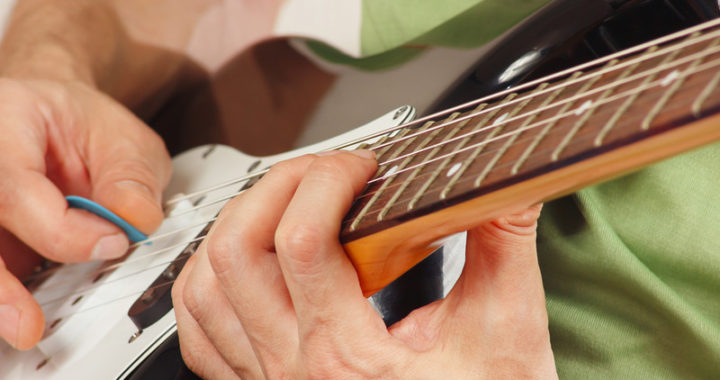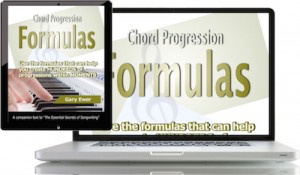Melody notes only sound right if the chords underneath them fit properly. If you’re a chords-first songwriter, you need to say it the other way — chords only sound right if the melody you eventually write fits them.
But in any case, good songs are a partnership between melodies and chords, and then they need to be the proper vehicle for the lyrics.
 If you’re stuck trying to add chords to your melodies, you need “How to Harmonize a Melody.” Shows you how to do it, step-by-step, with sound samples to guide you.
If you’re stuck trying to add chords to your melodies, you need “How to Harmonize a Melody.” Shows you how to do it, step-by-step, with sound samples to guide you.
It seems like a no-brainer to say that the notes of a melody need to be found in the chords that accompany them, but this is only part of the story. If that were strictly true, you’d only be able to have melodies that use chord tones, so all your melodies would be leaping about, only using the notes of the triads.
But of course melodies are a mixture of mostly stepwise motion with occasional leaps. So in fact, many notes that we hear in a melody are not actually found in the chords underneath.
So how does that work? How can you have melody notes that don’t exist in the accompanying chords? Take a classic like “Groovy Kind of Love.” Its melodies are made up mainly of stepwise motion, with many notes per chord:

The first few melody notes happen unaccompanied, but then we get several notes (E D C# B A) that all happen over one chord. How do they all sound fine being accompanied by that one chord, A?
It’s All About Strong and Weak Beats
Listeners automatically feel the strong beat/weak beat pattern of music, and this is a crucial part of what makes a chord fit the melody. When you listen to “Groovy Kind of Love”, your foot automatically starts tapping within a few seconds of the start of the song.
Those foot taps that you instinctively do are the beats. If you really pay attention, you’ll notice that some beats feel strong while others feel weak, and in most songs that’s an alternating pattern:
WHEN i’m FEEL-ing BLUE
ALL i HAVE to DO
is TAKE a LOOK at YOU
THEN i’m NOT so BLUE
The sense of strong and weak is subtle, but it’s there in practically every song in the pop genres.
Strong and weak beats are important to harmonizing a melody, because that governs when it feels right to hear a chord change. In general, it feels right when a chord changes on the strong beats.
Take a look at the lyric in the graphic above, and you’ll notice that chords are always changing on the strong beats.
In between strong beats, we’re completely fine if the notes of the melody don’t necessarily come from the chord that’s happening at that moment:
CHORDS: [...] A E9 A LYRICS: [...] ALL i HAVE to DO / is TAKE a LOOK at YOU Notes: [...] D C# B A G# G# A G# F# G# A
Most of those notes in between the chords don’t come from the chord of the moment. But the listeners’ ears accept those notes because they happen during those so-called weak beats.
The good news is that most of the time our instincts take care of this detail. You don’t normally have to think too hard about whether a melody note belongs or doesn’t belong to a chord. For 95% of the time, the note that happens on a strong beat needs to belong to the chord, and the other notes act as musical glue that gets you from one strong beat to the next one.
 Written by Gary Ewer. Follow Gary on Twitter.
Written by Gary Ewer. Follow Gary on Twitter.
“Chord Progression Formulas” is an eBook that shows you how to create dozens of progressions quickly and easily, using simple, tonally strong formulas. It’s perfect for chords-first songwriters.












And I have another question too,if we play non-chord tones on weak beats ,can we leave them unresolved?
I know the rules of common non-chord tones like passing tone, neighbor tone, anticipation etc
But are there any other way except these classic ways to resolve non-chord tones?
Thanks in advance Mr Ewer for your amazing articles
So if we play a Melody note not from the chord below and we play that note on a strong beat ,do we make a new chord?and does Melody combined by chord can be considered as chord of that bar?
For example if we play F on Gmajor chord then we make a G7 chord?
Yes, in effect, the non-chord note of the melody will actually create a different chord name, and the example you give (adding F to a G chord) will, to a listener, make it sound like a G7. That really only happens with melody notes pairing with strong-beat chords. But having said that, I’ve seen lots of chord charts that won’t bother adding the ‘7’ to the G chord, and I’m assuming that they think that since the singer is going to sing that 7th, it will be present whether the guitarist plays the 7th or not.
-Gary